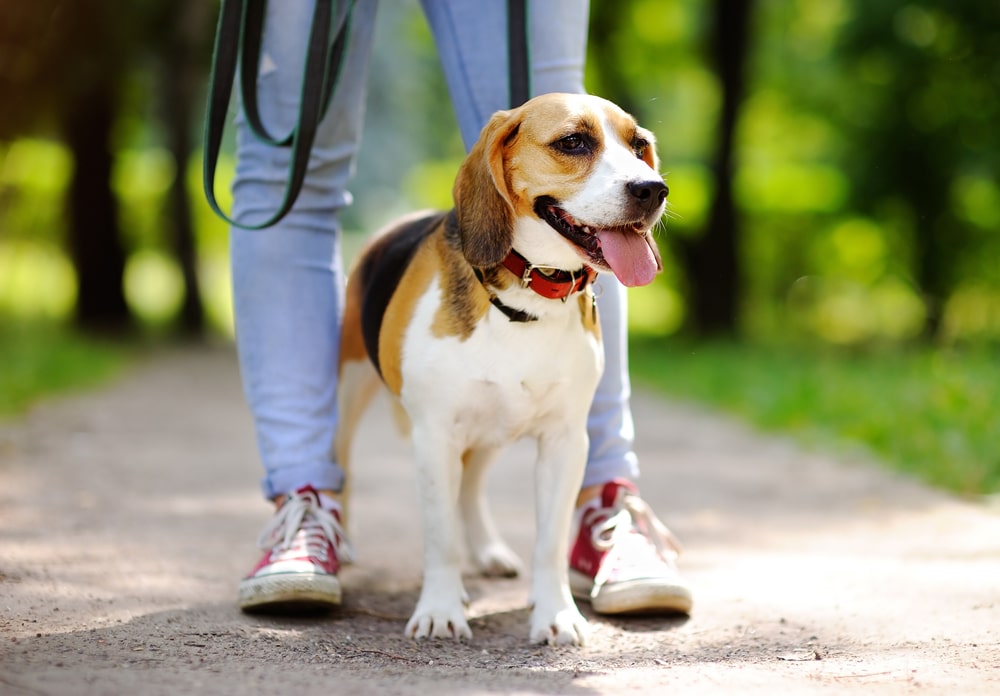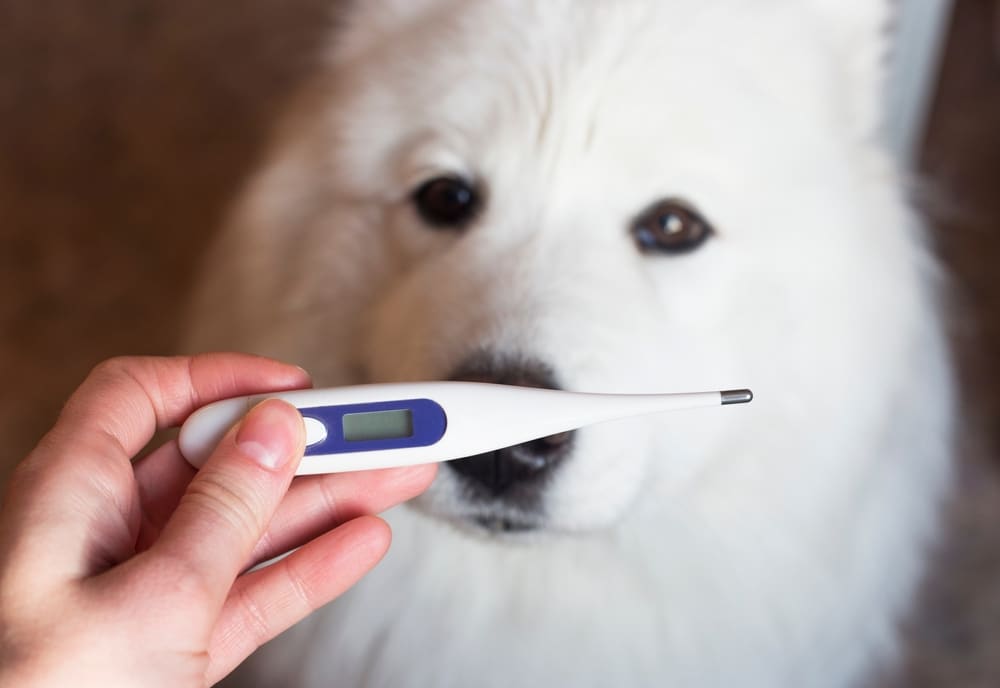If your dog feels warm to the touch, you may have heard you should dab some alcohol on its paw pads to cool it down. So, how exactly does alcohol lower body temperature in a dog?
Alcohol evaporates rapidly from your dog’s skin surface and carries away the body heat through conduction and convection, thus lowering body temperature. Be aware that even though this happens, dogs and alcohol should never mix. Alcohol is extremely dangerous to a dog. If your dog is too hot, there are other, safer ways to cool it down such as moving it to the shade, putting a fan nearby, or turning up the air conditioning. If your dog still won’t cool down, contact your veterinarian.
Table of Contents
Normal Heat Loss And Temperature Regulation In A Dog
We’re going to start this topic by explaining what looks normal for dogs. We’ll also take a look at what are some causes of higher temperatures in dogs.
Where Do Dogs Usually Lose Heat From?
When our bodies start to overheat, our brains send messages to various body parts to kickstart temperature-regulating mechanisms to help cool us down. One such process is vasodilation or the widening of blood vessels near the skin surface, which allows heat to be lost by convection and radiation.
Unlike humans and some other animals, dogs do not have sweat glands all over their bodies. As you may already know, sweating helps us bring down our temperature because it carries heat away as it evaporates from our skin surface. Dogs only have sweat glands on their paw pads and these only play a minor role in regulating their temperature; panting is the most efficient way for them to expel excess heat.
Causes Of High Temperature In Dogs
A dog’s normal body temperature is 101.0 to 102.5°F (38.3 to 39.2°C) as measured rectally. An increase beyond this may indicate a fever, which could be a symptom of an underlying disease or infection. Other causes of elevated body temperature include exercise or excitement as well as heatstroke.
Why It’s Necessary To Lower The Body Temperature Of Your Dog

Prolonged periods of temperatures beyond the normal range can be detrimental to normal functions. Enzyme activity is impaired and cells may die, releasing substances into the blood that can damage organs such as the kidney.
However, the most important aspect of this issue is identifying the underlying cause of an elevated temperature. A fever caused by infection is beneficial as it helps the body optimize its defenses against invading organisms. Lowering your dog’s temperature will not address the primary cause of the elevated body temperature. In these cases, it is important to see a veterinarian for a thorough assessment.
On the other side of things, during a heat stroke, your dog loses the ability to control its temperature, causing it to rise rapidly. In this situation, steps must be taken to help your dog cool down as soon as possible.
Latest Recommendations
Research is always changing. So, as of November 2022, here’s what we found for you.
The Problem With Using Alcohol To Lower Body Temperature In A Dog
Current research no longer recommends alcohol as a way to cool down the body temperature of your dog if it is overheating. The consensus is that the rapid natural evaporation of alcohol may cause too much localized heat loss too fast, causing the body to switch on mechanisms to preserve the heat that it should be trying to lose.
Blood vessels in the peripheral regions constrict, trapping the excess heat in your dog’s core – closer to the vital organs. This can be rapidly detrimental to their functioning and contribute to potential organ failure.
The Dangers Of Using Alcohol To Lower Body Temperature In A Dog
Outside of having the opposite intended effect when used on the paw pads, alcohol may not have any intended side effects. However, we still don’t recommend putting any alcohol on dog paw pads to cool down their body temperature due to the possibility of absorption. In addition, inhalation of large amounts of alcohol vapor or accidental ingestion can lead to irritation of the upper airway, nausea, dizziness, and nervous signs in dogs.
Other Methods To Lower Body Temperature
Although extreme body temperatures are an emergency (which we recommend contacting a vet for), a slow and steady approach is key to successful management. Once you have identified the increased temperature does not have an infectious cause, some other methods you can use to safely lower your dog’s temperature by active cooling are:
- Move the dog to a shaded area, preferably with cool flooring. Avoid using bedding or blankets.
- Use a fan – pedestal fans directed at your dog’s belly work best but you can also use a book or newspaper to fan your dog’s body and encourage air circulation.
- Pour lukewarm to cool water slowly over your dog’s body. Do NOT use cold or iced water because this may cause shock and peripheral vasoconstriction. Remember, slow and steady! Studies show water at (15-16°C) is ideal. Avoid pouring water on your dog’s head as this may cause accidental aspiration or choking.
- Regularly allow your dog to drink small amounts of cool water. They will likely be panting heavily, so monitor them closely as they drink to look for signs of choking
- Get your dog to a vet as soon as possible! Research shows that dogs who have been administered active cooling therapy at home have a higher chance of survival. However, they still need a thorough work-up by a veterinarian to assess and rectify any damage that may have occurred. Your vet may choose to administer IV fluids, often considered the cornerstone of treating heat stress in dogs.
When using these methods, you mustn’t cause your dog’s temperature to drop too low. Hypothermia is a dangerous consequence of inordinate external cooling. So, if you don’t feel comfortable, you can always contact your vet for assistance.
When To See A Veterinarian
Knowing when to see a veterinarian for these issues is key to keeping your dog healthy and safe. So, here’s when to go see one.
Fever Is A Symptom, Not An Illness
Pyrogenic fever or fevers of infectious origin must be differentiated from heat stress. Dogs with an infection usually appear lethargic, may have reduced appetite, and show other clinical signs in the days leading up to the fever. The increase in temperature is usually more gradual and not accompanied by attempts at self-cooling, such as panting.
Heat stress is typically seen in dogs that have been exercising outside or left inside a hot car on a sunny day, which no one should ever do. They don’t seem to have any prior signs of illness but may suddenly begin panting and drooling excessively, develop very hot and reddened skin, and show signs of disorientation or collapse. Heat stroke is a medical emergency, and you must start actively cooling your pet at home while preparing to take it to the nearest veterinary clinic.
The Importance Of Treating The Underlying Syndrome
Unless the underlying cause of your dog’s elevated temperature is identified and addressed, pyrogenic fevers will often recur. Treating the fever symptoms will not cure the disease. If the condition is of bacterial or viral origin, your veterinarian will be able to provide medication to destroy the pathogens and help the body eliminate them.
Heat stroke can also be avoided. While the risk of overheating is not exclusive to any breed, recognizing that some dogs such as brachycephalics (dogs with short heads) are more prone can prevent future episodes.
In Conclusion: There Are Safer, More Effective Alternatives Than Rubbing Alcohol To Cool Down The Body Temperature Of A Dog
We’ve all heard of the old practice of using rubbing alcohol to lower the body temperature of a dog. But science and medicine are constantly changing and growing! We now recognize there are more effective alternatives that are much safer for your pet. All the methods described above are only the first steps in managing overheating pups; they must always be followed up by a visit to your veterinarian.
So, what are your thoughts on this? Have you ever had a scare like this with your dog before? Let us know your thoughts and why in the comments below!
